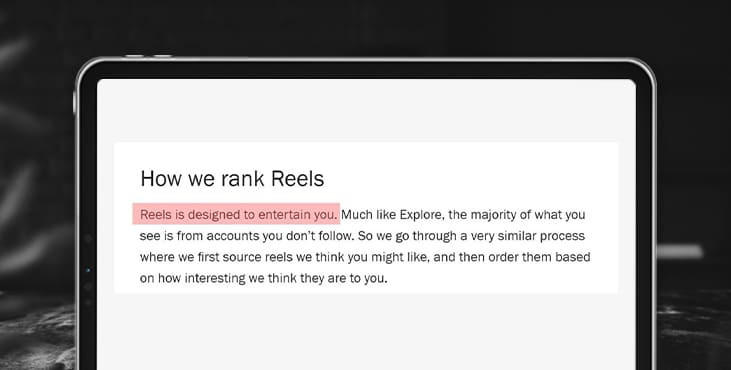
How does the Instagram Reels algorithm work?
The Reels format is designed to entertain people, so the algorithm is set to show as much fun content as possible in the feed.
As in the case of the recommendations, most of what the user sees is created by accounts which the person does not follow. Therefore, the algorithm first finds videos that, in its opinion, a person might like, and then arranges them, trying to take into account the likely actions of the user.
The most important predictions it makes are: high chances that a person will watch the video to the end, like it, say that it was interesting or funny, and go to the page with music. Going to the section with audio tracks is an indirect indicator that the watched video inspired a person to create their own video.
In addition to predictions, the algorithm also ranks videos using signals. Here are the most important ones:
User activity. Instagram looks at what videos a person liked, what comments they left, and what they interacted with recently. These signals help the algorithm understand what content might be relevant to the viewer.
History of user interaction with the Reels author. If the viewer at least once somehow interacted with the author of the video, then this gives a signal to the algorithm to show new content.
Information about the video. These are signals about the technical content of the video: what audio track is used, what is the video resolution in pixels, how many frames are in the video, and what is its overall popularity in the service.
Information about the Reels author. The last thing Instagram takes into account is the popularity of the author: how many followers the author has, how active they are, how quickly popularity is growing. The social network is trying to give impressions not only to stars, but also to small authors.
Do hashtags work on Reels? Yes, they work in the same way as hashtags for posts. According to my personal observations, they are now given priority for getting into the top.

What can I do to get more impressions on Reels?
In order for a video to get into the Reels feed, it must not show something that can somehow upset or offend a person. For example, a scene of a fight or an accident can be regarded by the social network as content that is difficult to perceive and removed from the feed. Also, videos can be restricted because of the smoking scene because anything that requires legal regulation is less likely to get coverage.
Instagram is struggling with cheating. If the social network notices fraudulent ways to get likes, then such an account may receive less coverage. There are many requirements and you can see the entire list in the Instagram Help Center.
The social network also does not recommend shooting at low resolution or uploading videos with watermarks from TikTok or video editors. If you want to transfer your videos to Reels, we advise you to cut them.
Also, Instagram does not recommend uploading Reels dedicated to political issues. The algorithm tries not to show videos made or published on behalf of politicians, parties or government officials.
The algorithm works automatically, but Instagram constantly collects feedback. From time to time, the social network polls users to find out if this or that video was entertaining or funny for them. Based on the feedback received, Instagram improves the algorithm to offer even more entertaining videos. At the same time, in this assessment, it mainly focuses on small authors.
Let's summarize
To determine which Reels to show to a user, Instagram takes into account how likely you are to:
- watch the Reel to the end;
- like it;
- say that it amused you or seemed funny;
- go to the page with music to shoot your own video.
To get more reach on Reels, Instagram recommends:
- Do not shoot low resolution videos with watermarks.
- Try not to make videos that can somehow upset or offend people.
- Don’t shoot Reels on political topics and don't post videos from politicians, parties and officials.
Get an audit of your social media account as a bonus
Tell us what you think
By clicking 'Submit', you agree to Privacy Policy and authorise our staff to contact you. You are liable under the Personal Data Protection Act if you key in false personal data or other people’s personal data.
offers and news
